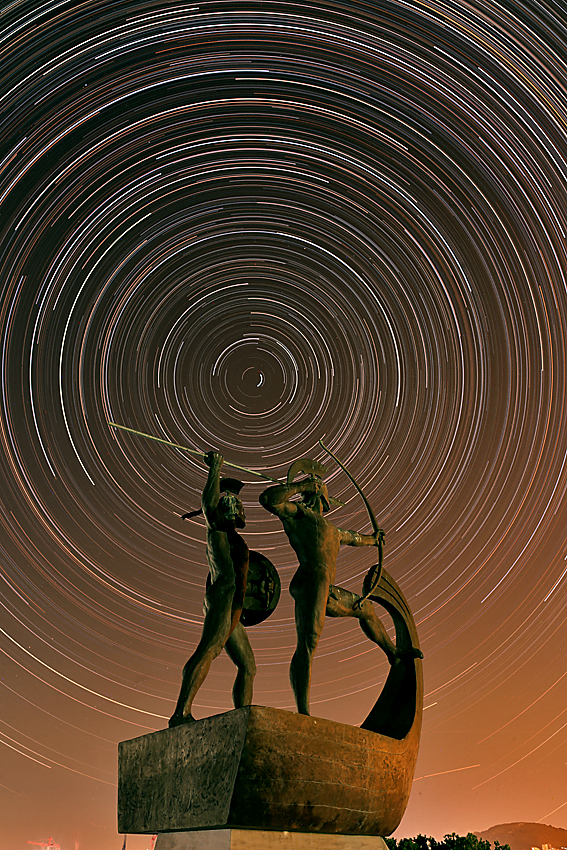
One of the most basic types of astrophotography and yet equally stunning is that involving star trails, particularly
around the celestial poles or immediately due east or west. In addition to capturing the motion of stars around the
north pole which are circumpolar and, hence, never rise or set, we also have the ability to capture seasonal
constellations and stars in such photos, thus allowing for different opportunities during different seasons. Star trail
photos also provide direct evidence that our planet rotates and does so at a rate of 15° per hour. Furthermore, by
studying the arc for a particular star, especially as far away from the pole as possible, one can indirectly estimate
the length of the (total) exposure which often ranges from seven to eight hours in duration and is totally dependent
on the end of astronomical twilight one evening and its onset
the following morning.
Many star photos are centered on Polaris, a double star system which represents our quickest means to locating the
north celestial pole, for it lies less than 1.0° from it, and is an excellent starting point for the polar alignment
of a telescope (and finding your way home if you are lost!). Due to the extended length of the typical exposures
involved, the best film for such work is Kodak Elite Chrome (ISO 100) whose reciprocity failure is nearly zero or
Fujichrome Velvia and Provia (ISO 50 and 100) emulsions with equally impressive curves! With respect to equipment, it
is rudimentary, for a camera with extended exposure capibility is required along with a firm tripod and shutter
release and locking cable. It is also preferable that the camera used have a mechanical shutter so that battery
consumption and power does not become an issue during mid-exposure. The final requirement is a location with dark
skies - the darker the better so that the trails and their colouration will be as bright and contrasty as possible -
with, preferably, an interesting foreground which can be used to enrich the final result.
Note: The island of Salamina lies in the Saronic Gulf and approximately 1200 meters at its
closest points from mainland Greece and immediately due west of Athens. It represents one of the most significant
historical locations from the time of Ancient Greece. More specifically, Salamina is the location of the second phase
of the second great battle between the Greeks and the Persians which occurred in 480 BC and ten years after the battle
at Ancient Marathon (490 BC) 40 km northeast of Athens. Under the command of King Darius I, the Persian army's first
attempted invasion of Greece was turned back as Miltiades and his far outnumbered Athenian army aided by the Plataeans
successfully turned back Darius and his invading forces. The Persians would return ten years later and under the direction
of King Darius' son Xerxes I for a second invasion attempt but now at Thermopylae ("The battle of the 300") where Leonidas
and his 300 warriors from Sparta put up an epic and brave battle against Xerxes and only to succumb after a traitor
informed the Persians of a secret trail which led them behind the Spartan line of defence. The epic Battle at Thermopylae
was followed immediately thereafter by the (naval) Battle at Salamis (also 480 BC) where Greek naval forces led by
Themistocles successfully managed to turn back the Persian naval forces and in spite of being outnumbered by four to one
(according to the historian Herodotus). The bronze sculpture monument below, designed by Achilles Vasileiou, was erected
in 2006 and honours the warriors at the Battle of Salamis ("Μνημείο Σαλαμινομάχων").
The sculptor is also well-known for his stunning bronze statue honouring the mythical winged-stallion
Pegasus of Corinth.
Note: For additional results with notable foregrounds from around the world involving the overhead
sky during the day and/or night, please click here.
|
Proper Star Name: Polaris Bayer Letter: α Ursae Minoris Tycho Catalog: TYC 4628-237-1 SAO Catalog: SAO 308 Luminosity 2290 +/- 282 x Sun Distance: 431 +/- 26 light yrs RA / Dec: 02h 53m 25s / +89° 19' 51" B-V Color Index: +0.570 mag Magnitude: 1.98 |
 |
Date: July 22-23, 2017 22:30 - 04:35 UT+3 Location: Salamina, Attiki, Greece Equipment: Canon EOS 6D Baader BCF2 Filter Canon EOS EF 28mm/f1.8 USM @ f6.3 Exposures: 365 min (707 x 30 sec) (RGB) 005 min (010 x 30 sec) (Dark) ISO 800 JPG Fine Image Format 5472x3648 Image Size Custom White Balance Continuous Servo Mode Software: Startrails V2.3 Photoshop CS5 Processing: Dark Frame Reduction Layers and Lighten Resampling Unsharp Masking JPG Compression |